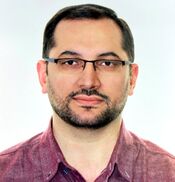Difference between revisions of "ULI101"
Ahadalioglu (talk | contribs) |
|||
| Line 1: | Line 1: | ||
| − | |||
{| style="float: right; margin: 0 0 3em 2em; border: 1px solid black;" | {| style="float: right; margin: 0 0 3em 2em; border: 1px solid black;" | ||
!style="background: #cccccc"| Quick Links | !style="background: #cccccc"| Quick Links | ||
|- | |- | ||
| − | |<div style="background:#ffff00" | + | |<div style="background:#ffff00">[https://wiki.cdot.senecacollege.ca/wiki/OPS235_Weekly_Schedule_-_CentOS7 Weekly Schedule]</div>[https://scs.senecac.on.ca/course/ops235 Course Outline] |
|- | |- | ||
!style="background: #cccccc"| Assignments | !style="background: #cccccc"| Assignments | ||
|- | |- | ||
| − | | | + | |[https://wiki.cdot.senecacollege.ca/wiki/OPS235_Assignment1 Assignment 1] |
| − | + | [https://wiki.cdot.senecacollege.ca/wiki/OPS235_Assignment2 Assignment 2] | |
| − | |||
| − | |||
|} | |} | ||
| − | = Welcome to | + | = Welcome to OPS235 - ''Introduction to Open System Servers'' = |
| + | {| width="100%" align="right" cellpadding="10" | ||
| + | |- valign="top" | ||
| + | | width="55%"| | ||
| + | == What This Course is About == | ||
| + | |||
| + | <u>This course is the second in a series of courses about Linux technologies</u> | ||
| − | + | :* ULI101 taught you to be a Linux ''user''. In OPS235, you will move from being Linux a ''user'' to being a Linux system ''administrator''. | |
| − | This | + | :* As a system administrator, you will be responsible for installing, configuring, adjusting, maintaining, and troubleshooting the operation of computer systems. This is a lot of responsibility, and with that responsibility comes power. You will be able to change anything on the system, and you will also have the ability to damage or destroy the system. |
| − | :* | + | :* In this course you use an external SSD drive (USB 3) with the lab computers to set up a Linux system. You will also set up at least four additional Linux systems using "Virtual Machines", and therefore gain experience with different types of system configurations as well as setting up networking between systems. |
| − | :* | + | :* Later courses (OPS335 and OPS435) teach you to administer Linux servers (web servers, DNS servers, FTP servers, file sharing servers) -- and to use more complex scripting to boost your system administration efficiency. |
== Learning by Doing == | == Learning by Doing == | ||
| − | Most of the learning in this course occurs through | + | Most of the learning in this course occurs through the hands-on problem solving that takes place in the eight labs and two assignments. |
| − | Requirements for Success | + | <u>Requirements for Success</u> |
| − | :* It is important to stay up-to-date with | + | :* It is very important to stay up-to-date with the coursework, and to practice until you have confidently mastered each task. |
| − | :* All software used in this course is ''open source | + | :* All of the software used in this course is ''open source'' software, so you are free to use, modify, and redistribute it. This means that you can install it as many times as you want on as many different computers as you would like. It also means that you can tinker with it -- you can take it apart, see how it works, and put it back together in the same or a different way, limited only by your time and ambition. You are encouraged to experiment and question liberally. |
| − | :* The notes you make | + | :* The notes that you make during the labs and assignments are your reference material for the quizzes, tests, and assignments. Take really good notes, and if you have questions, experiment and consult with your professor. |
| − | :* Carefully read ALL lab instructions and check your work regularly. The labs have been designed with backup safeguards to prevent the student from losing their work. | + | :* Carefully read ALL lab instructions and check your work regularly. The labs have been designed with backup safeguards to prevent the student from losing their work. On the other hand, students may lose their work if they fail to follow lab instructions or accidentally forget their removable hard disks in the workstation's hard disk bay drive! |
| − | == Course | + | == Course Faculty == |
| − | + | '''During the <b>Fall 2019</b> semester, OPS235 is taught by:''' | |
| − | |||
| − | = | + | | width="40% | |
| − | + | ==Required Materials (for second class)== | |
| + | <table cellpadding="10" cellspacing="0" width="100%"><tr><td width="10%" style="border-bottom: thin solid #cccccc;">[[Image:ssd.png|left|95px]]</td><td width="20%" style="border-bottom: thin solid #cccccc;padding-top:25px;padding-bottom:25px;">'''Solid State Drive (SSD)'''</td><td width="20%" style="border-bottom: thin solid #cccccc;text-align:right;">'''Minimum Capacity:''' 240 GB</td></tr><tr valign="top"><td width="10%" style="border-bottom: thin solid #cccccc;">[[Image:blank-cd.png|left|50px]]</td><td width="20%" style="border-bottom: thin solid #cccccc;">'''CentOS 7 Full Install<br>DVD Image'''</td><td width="20%" style="border-bottom: thin solid #cccccc;text-align:right;">[https://mirror.senecacollege.ca/centos/7/isos/x86_64/CentOS-7-x86_64-DVD-1810.iso Download at Seneca Lab]<br>[http://mirror.netflash.net/centos/7/isos/x86_64/CentOS-7-x86_64-DVD-1810.iso Download from Home]</td></tr><tr><td width="10%" style="border-bottom: thin solid #cccccc;">[[Image:ubs-key.png|left|50px]]</td><td width="20%" style="border-bottom: thin solid #cccccc;padding-top:25px;padding-bottom:25px;">'''USB Flash Drive'''<br>(3.0 preferred)</td><td width="20%" style="border-bottom: thin solid #cccccc;text-align:right;">'''Minimum Capacity:''' 16 GB</td></tr><tr><td width="10%" style="border-bottom: thin solid #cccccc;">[[Image:log-book.png|left|44px]]</td><td width="20%" style="border-bottom: thin solid #cccccc;">'''Lab Log-book'''<br>(download & print<br>Both sides per lab permitted)<br><b>NOTE: If you've taken this<br> class in a previous semester, <br>you MAY NOT bring that <br>version of the lab logbook<br>to any testing.</b></td><td width="20%" style="border-bottom: thin solid #cccccc;text-align:right;">[[:File:Ops235_logbook.pdf|Download PDF]]</td></tr><tr><td width="10%" style="border-bottom: thin solid #cccccc;padding-top:25px;padding-bottom:25px;padding-left:25px;"><span style="font-size:3em;font-family:arial;color:red;font-weight:bold;">!</span></td><td width="20%" style="border-bottom: thin solid #cccccc;">'''Dos and Don'ts'''</td><td width="20%" style="border-bottom: thin solid #cccccc;text-align:right;">[http://zenit.senecac.on.ca/wiki/index.php/OPS235-tips tips]</td></tr></table> | ||
| + | |} | ||
| + | {|cellpadding="15" width="70%" | ||
| + | |- valign="top" | ||
| + | |[[Image:AhadM_200x200.jpg|thumb|left|175px|<b>Ahad Mammadov</b><br>(Sections '''A''' and '''C''')<br>[mailto:ahad.mammadov@senecacollege.ca ahad.mammadov@senecacollege.ca]<br> ]] | ||
| + | |[[Image:chris.jpg|thumb|left|168px|<b>Chris Johnson</b><br>(Section '''B''')<br>[mailto:chris.johnson@senecacollege.ca chris.johnson@senecacollege.ca]<br> ]] | ||
| + | |[[Image:petercallaghan.jpg|thumb|left|223px|<b>Colin Yip</b><br>(Sections '''D''' and '''E''')<br>[mailto:colin.yip@senecacollege.ca colin.yip@senecacollege.ca]<br /> ]] | ||
| − | <!-- | + | <!-- |
| − | + | |[[Image:petercallaghan.jpg|thumb|left|235px|<b>Michael Huang</b><br><font size="1">(Section '''A''' and '''B''' (May - Aug), <br>and '''C''' for May/June''')<br>[mailto:hong.huang@senecacollege.ca hong.huang@senecacollege.ca]</font><br> ]] | |
| − | + | |[[Image:AnthonyAustin.jpg|thumb|left|350px|<b>Anthony Austin</b><br>(Sections A, B, and C)<br>[mailto:anthony.austin@senecacollege.ca anthony.austin@senecacollege.ca]<br> ]] | |
| − | | | + | |[[Image:EricBrauer.jpg|thumb|left|125px|<b>Eric Brauer</b><br>(Sections '''D''' and '''E''')<br>[mailto:eric.brauer@senecacollege.ca eric.brauer@senecacollege.ca]<br> ]] |
| − | | | + | |[[Image:kent.png|thumb|left|325px|<b>Kent Poots</b><br />Sections '''?''' & '''?''' <br />kent.poots.seneca@gmail.com<br />[http://www.drivehq.com/sharing/ShareLogon.aspx?key=10226970/l90aboda8mq8 Kent's class materials] ]] |
| − | |[[Image:kent.png|thumb|left|325px|<b>Kent Poots</b><br />Sections ''' | + | |[[Image:marcos.jpg|thumb|left|225px|<b>Marcos Cavenaghi<br />(Second Half)</b><br />Sections: '''B''' , '''C''' & '''D'''<br /><br /> ]] |
| − | |[[Image: | + | |[[Image:MikeMartin.jpg|thumb|left|225px|<b>Mike Martin (Second Half)</b><br />Sections: '''A''' <br />mike.martin@senecacollege.ca<br />[http://scs.senecac.on.ca/~mike.martin// Mike's web-site] ]] |
| − | |[[Image:murraysaul.jpg|thumb|left| | + | |[[Image:MarkFernandes.jpg|thumb|left|300px|<b> Mark Fernandes</b><br>(Section '''F''')<br> mark.fernandes@senecacollege.ca<br />[http://cs.senecac.on.ca/~mark.fernandes Mark's web-site] ]] |
| − | | | + | |[[Image:andrew-o-w.png|thumb|left|300px|<b>Andrew Oatley-Willis</b><br>(Sections '''C''', '''E''' & '''G''')<br> |
| + | andrew.oatley-willis@senecacollege.ca<br />]] | ||
| + | |[[Image:HansHeim.jpg|thumb|left|230px|<b> Hans Heim</b><br>(Section '''N/A''' )<br> hans.heim@senecacollege.ca<br />[http://hansheim.blogspot.ca/ Hans's Instructor Page] ]] | ||
| + | |[[Image:murraysaul.jpg|thumb|left|200px|<b>Murray Saul</b> (First Half)<br>(Sections '''A''' , '''B''' & '''C''')<br>murray.saul@senecacollege.ca<br />[http://murraysaul.wordpress.com/ Murray's web-site] ]] | ||
| + | |[[Image:azzad.jpg|thumb|left|230px|<b>Azzad Kara</b><br>('''Spring:''' Section '''CC''')<br> azzad.kara@senecacollege.ca<br> ]] | ||
| + | |[[Image:andrew.jpg|thumb|left|185px|<b>Andrew Smith (First Half)</b><br />Sections '''C''' and '''D'''<br />andrew.smith@senecacollege.ca<br />[http://littlesvr.ca/currentposition.php Andrew's schedule] ]] | ||
| + | |[[Image:elizabeth.jpg|thumb|left|215px|<b>Elizabeth Kopiec</b><br>(Section '''D''')<br>elizabeth.kopiec@senecacollege.ca<br>[https://scs.senecac.on.ca/staff/kopiec-elizabeth Elizabeth's web-site] ]] | ||
| + | |[[Image:petercallaghan.jpg|thumb|left|235px|<b>Andres Lombo</b><br>(Section E)<br>[mailto:andres.lombo@senecacollege.ca andres.lombo@senecacollege.ca]<br> ]] | ||
| + | --!> | ||
|} | |} | ||
| − | + | == Wiki Participation == | |
| + | |||
| + | * You can edit these pages! Please feel free to fix typos or add links to additional resources. Please use this capability responsibly. | ||
| + | |||
| + | |||
| + | [[Category:OPS235]] | ||
Revision as of 06:32, 4 September 2019
| Quick Links |
|---|
| Course Outline |
| Assignments |
| Assignment 1 |
Contents
Welcome to OPS235 - Introduction to Open System Servers
What This Course is AboutThis course is the second in a series of courses about Linux technologies
Learning by DoingMost of the learning in this course occurs through the hands-on problem solving that takes place in the eight labs and two assignments. Requirements for Success
Course FacultyDuring the Fall 2019 semester, OPS235 is taught by: |
Required Materials (for second class)
|
|
|




